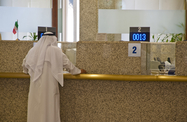The banking sector performed strongly in 2014, led by Abu Dhabi’s raft of big-ticket projects, which have proved to be a key driver of growth for larger lenders. However, signs that the market is becoming increasingly crowded, particularly in the retail segment, are prompting several players to look beyond the UAE’s borders for new business.
After a solid performance in 2013, the group of banks often referred to collectively as Abu Dhabi’s ‘big five’ began 2014 in similar vein, with each lender posting a net profit in the first six months of the year. Data shows that the combined assets of the five banks – National Bank of Abu Dhabi (NBAD), Abu Dhabi Islamic Bank (ADIB), First Gulf Bank (FGB), Abu Dhabi Commercial Bank (ADCB) and Union National Bank (UNB) – totalled AED942.4bn ($256.5bn) at the end of the first half, up from AED893bn ($243.1bn) at the end of 2013.
NBAD recorded the largest profit in absolute terms, up 7.7% year-on-year to AED2.83bn ($770m), while the highest percentage gain for the period was posted by ADIB, with a 34.4% jump in net profits to AED855m ($232.7m).
Ratings agency Moody’s estimates that growth at NBAD − among the top 5% of banks rated by Moody’s globally − will be strong for the year as it nears double digits, driven by high public spending that is stimulating growth in the non-oil economy. The government of Abu Dhabi, for which NBAD is the primary banker, has budgeted projects of around $90bn for 2013-17, which will create business opportunities for the bank, the ratings agency noted.
However, dropping oil prices may add pressure to the outlook for GCC economies and their banks. A recent report by the IMF noted that banks in the region might struggle to diversify their credit portfolios due to the structure of the economies and with the non-oil sectors significantly linked to oil.
Outward bound
NBAD’s CEO Alex Thursby used the UAE Global Investment Forum in November as a platform to outline the bank’s plans to seek growth within a “West-East corridor” spanning Western Africa, the MENA region and the Far East.
Thursby told OBG that markets located throughout the corridor, which include both established cities and expanding hubs, were of huge importance. “This region represents vast potential with unlimited resources, growing economic activities, and an emerging middle class,” he said, as the bank looks to establish five international bank franchises within the most rapidly-growing countries. “Trade and foreign direct investment flows across the corridor are growing, in some cases more than 10%,” he told OBG.
NBAD expects trade and investment levels across the corridor to grow in double figures in most areas. According to the bank’s data, intra-Asian FDI reached $213bn in 2011 and is expected to triple to $614bn by 2020. Markets where FDI has run at lower levels to date, show an even greater potential for expansion. Intra-African FDI is expected to reach $15bn by 2020, up from $2bn in 2011and signalling a CAGR of around 25%.
Extending the reach
Several of Abu Dhabi’s other lenders are eyeing opportunities further afield, including FGB, which made a significant advance into the Asia Pacific Market this year when it opened a representative office in South Korea and added a Global Wealth Management unit to its Singapore branch. The bank has also announced plans to open an office in China.
UNB has a presence in the sizeable Egyptian market as a result of its acquisition of Alexandria Commercial and Maritime Bank, now called the Union National Bank of Egypt. Egypt is also the location for ADIB’s foreign expansion drive, following its acquisition of a 49% stake in the National Bank of Development. It has since opened branches in Iraq, Sudan and Qatar.
International expansion comes as the domestic market is becoming increasingly crowded, particularly at the retail end. In the UAE, 23 local banks and 28 foreign institutions, which hold commercial banking licences from the Central Bank, representing a banking density of 11.9 branches per thousand of the population, according to the World Bank, compared to Egypt’s 4.7 per thousand and Saudi Arabia’s 8.6.
For now, a number of industry giants with strong capital ratios are capable of financing large-scale projects as individual institutions or as part of consortia, and the rapid growth of the nation has provided sufficient business for them to expand their balance sheets. However, all players are looking to harness the country’s strategic location as they gear up to tap into some of the world’s fastest growing economies and trade routes.

